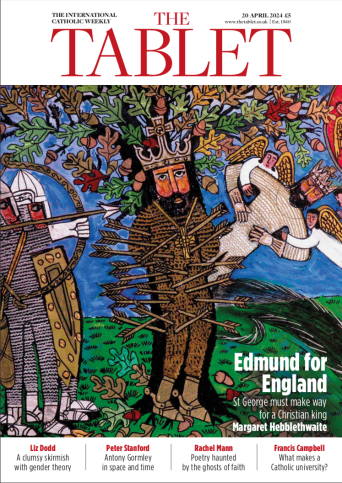“With Pope Francis, we are being called to follow the paths laid out by the [Second Vatican] Council and its teachings regarding the Church as communion,” said an enthusiastic Archbishop Bruno Forte.
The 64-year-old Italian is the Pope’s choice to serve as special secretary at next year’s Synod on the Family, and at the recent press conference to unveil the now well-known survey and preparatory document for that gathering, he looked like the happiest man in the room. “Pope Francis has shown many times and in various forms his intention to make greater use of episcopal collegiality, sign and tool of the broadest synodality of the entire Church,” the archbishop said. He more than subtly suggested that Francis was preparing for the upcoming synod assembly in the same way that John XXIII had drawn up plans for Vatican II.
He quoted these words that Pope John wrote in his diary on 19 January 1962, just nine months before the council got under way: “All is to be seen in the light of pastoral ministry; that is, in terms of souls to save and edify.”
An older colleague who covered Vatican II told me afterwards that the words sent shivers of excitement up his spine. The comment reflects a growing sense that Pope Francis wants to “open up the windows” in the Church by means of the synod, just as his saintly predecessor did through the council. Archbishop Forte will undoubtedly be among the most earnest supporters of that goal. Considered one of Italy’s finest theologians, he was long ago a disciple of the late Cardinal Carlo Maria Martini. Though he masked his “conciliar” and more “progressive” stripes over the past decade or so, the new pontificate may tempt him to show his true colours.
Nine tiny bones that Paul VI declared to be the true remains of St Peter the Apostle will go on public display for the first time on 24 November when Pope Francis celebrates Mass outside in St Peter’s Square to conclude of the Year of Faith. According to the Rome daily Il Messaggero, the bones – which are kept in a small reliquary in the “confessio” beneath the papal altar of St Peter’s Basilica – were briefly removed from the Vatican in 1981 when they were taken to the Gemelli Hospital where Pope John Paul II was recovering from an assassination attempt.
For centuries it was assumed, but never proved, that Peter’s tomb was at the base of the Vatican basilica. Pope Pius XII commissioned excavations in the 1940s to get to the truth of the matter, and during his Christmas radio message in 1950 declared that, indeed, the tomb been found. But regarding the bones that had been discovered in the necropolis, he said, “It is not possible to prove with certainty that they are part of the mortal remains of the Apostle.”
Paul VI commissioned further excavations in the early 1960s and the lead archaeologist, Margherita Guarducci, discovered that in the earlier endeavour, a Vatican labourer had removed other bones from a niche in the necropolis and taken them home in a shoebox. She was able to retrieve them and studies showed they belonged to a robust man in his sixties. She also found an inscription – “Petrus eni” (“Peter is here”). With great emotion, Pope Paul then solemnly declared there was “reason to believe that the few but sacrosanct mortal remains of the Prince of the Apostles” had been recovered. He did so in June 1968, at the end of the last Year of Faith.
Hundreds of thousands of Italian Catholics have flocked back to church since the election of Pope Francis. That was a claim made recently by Massimo Introvigne, head of Italy’s Centre for Studies on New Religions (Cesnur). He’s based it on a recent “survey” he conducted among 187 priests, 63 members of men’s religious orders and 261 laymen and -women. Introvigne says the results of his enquiry point to a “Francis Effect” that is bringing people back to the faith in droves.
That would be great news – if it were true. But, in fact, the evidence upon which he bases that conclusion is rather thin and unconvincing. The survey asked just two questions. The first asked respondents whether they perceived “a lasting positive effect on Catholics being re-energised or being prompted to return to the Church because they are moved by the Pope’s appeals for mercy”. Among the priests and Religious, 50.8 per cent responded yes, while 49.2 per cent said no. Among the laity, only 44.83 per cent answered in the affirmative, while 55.17 per cent said no.
Only those who responded in the negative were asked to answer the second question: “Did you perceive this ‘Francis Effect’ in the first months of the pontificate, and believe that it is now waning?” This time, 84.55 per cent of the clergy said yes, while the other 15.45 per cent said no. The yes-no divide among the laity was 64.86 per cent compared to 35.14 per cent. Mr Introvigne, who has close ties with Italy’s conservative politicians and good contacts in the Italian media, strategically released his “survey” just days before his latest book hit the shelves, Il segreto di papa Francesco.
Robert Mickens
14 November 2013, The Tablet
Letter from Rome
Edmund for England
 Loading ...
Loading ...
Get Instant Access
Subscribe to The Tablet for just £7.99
Subscribe today to take advantage of our introductory offers and enjoy 30 days' access for just £7.99



What do you think?
You can post as a subscriber user...
User Comments (1)
This is what the Year of Mercy is about.
Please don't let out-of-touch clerics turn it into a parade of archaic words, long prayers and elaborate ceremonies.
Please, Peter, let us hear the voices of priests like you more often and more loudly.